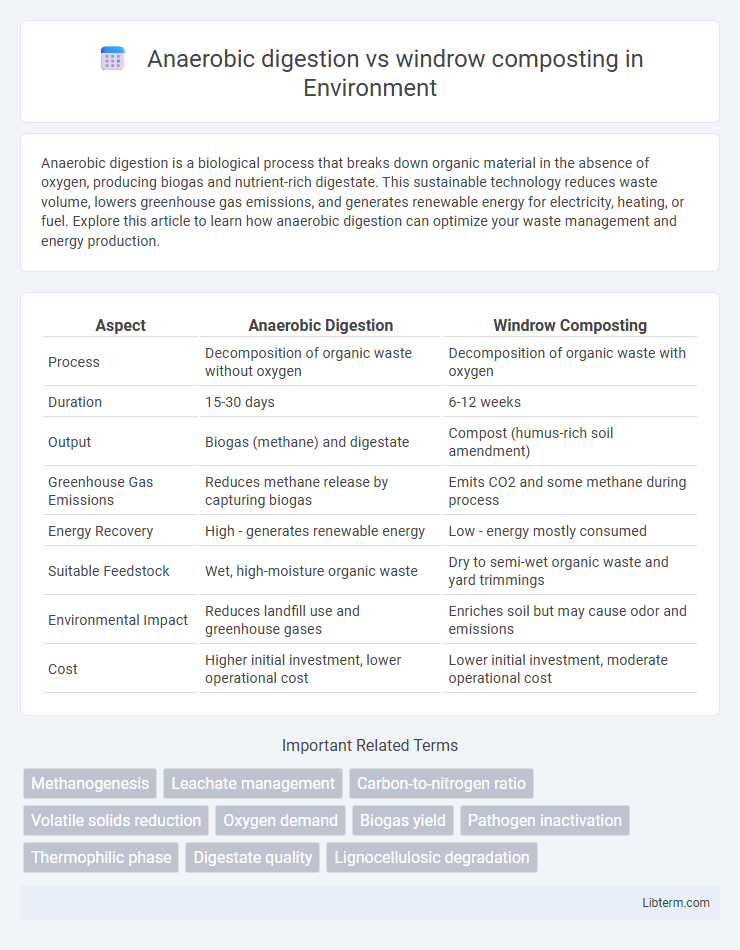Anaerobic digestion is a biological process that breaks down organic material in the absence of oxygen, producing biogas and nutrient-rich digestate. This sustainable technology reduces waste volume, lowers greenhouse gas emissions, and generates renewable energy for electricity, heating, or fuel. Explore this article to learn how anaerobic digestion can optimize your waste management and energy production.
Table of Comparison
| Aspect | Anaerobic Digestion | Windrow Composting |
|---|---|---|
| Process | Decomposition of organic waste without oxygen | Decomposition of organic waste with oxygen |
| Duration | 15-30 days | 6-12 weeks |
| Output | Biogas (methane) and digestate | Compost (humus-rich soil amendment) |
| Greenhouse Gas Emissions | Reduces methane release by capturing biogas | Emits CO2 and some methane during process |
| Energy Recovery | High - generates renewable energy | Low - energy mostly consumed |
| Suitable Feedstock | Wet, high-moisture organic waste | Dry to semi-wet organic waste and yard trimmings |
| Environmental Impact | Reduces landfill use and greenhouse gases | Enriches soil but may cause odor and emissions |
| Cost | Higher initial investment, lower operational cost | Lower initial investment, moderate operational cost |
Introduction to Organic Waste Management
Anaerobic digestion and windrow composting are two prevalent methods in organic waste management aimed at reducing waste volume and producing valuable byproducts. Anaerobic digestion utilizes microorganisms in oxygen-free environments to break down organic matter, generating biogas rich in methane, which serves as a renewable energy source. Windrow composting involves aerobic decomposition of organic waste arranged in long piles, producing nutrient-rich compost used to improve soil quality and promote sustainable agriculture.
Overview of Anaerobic Digestion
Anaerobic digestion is a biological process where microorganisms break down organic matter in the absence of oxygen, producing biogas primarily composed of methane and carbon dioxide. This process efficiently converts waste materials such as agricultural residues, manure, and food scraps into renewable energy and nutrient-rich digestate used as fertilizer. Compared to windrow composting, anaerobic digestion offers faster decomposition rates and significant energy recovery through biogas capture.
Understanding Windrow Composting
Windrow composting involves the aerobic decomposition of organic waste by turning large piles, or windrows, to maintain oxygen levels and optimize microbial activity. This process typically takes several weeks to months, producing nutrient-rich compost that enhances soil health and structure. Unlike anaerobic digestion, windrow composting does not generate biogas but is simpler to implement for managing yard waste and organic residues.
Comparative Process Flow: Anaerobic Digestion vs Windrow Composting
Anaerobic digestion involves the breakdown of organic materials by microorganisms in an oxygen-free environment, producing biogas and digestate through controlled reactor systems. Windrow composting relies on aerobic microbial activity by turning organic waste in elongated piles exposed to air, promoting aerobic decomposition and nutrient-rich compost formation. The key process difference lies in anaerobic digestion's sealed, oxygen-limited conditions versus windrow composting's open-air, aerobic conditions facilitating distinct microbial pathways and end-products.
Environmental Impact Assessment
Anaerobic digestion significantly reduces greenhouse gas emissions by capturing methane for energy production, minimizing odor and leachate risks compared to windrow composting. Windrow composting can lead to higher ammonia and nitrous oxide emissions due to its aerobic process and prolonged decomposition time. Environmental Impact Assessment highlights anaerobic digestion as a more sustainable option for managing organic waste with lower overall environmental footprints.
Energy Production Potential
Anaerobic digestion offers significantly higher energy production potential by converting organic waste into biogas, primarily methane, which can be directly used for electricity and heat generation. Windrow composting, while beneficial for nutrient recycling and soil improvement, produces minimal energy, as it relies on aerobic microbial activity without capturing biogas. The controlled environment of anaerobic digesters ensures more efficient biomass conversion and consistent energy yields compared to the open, slower process of windrow composting.
Space and Infrastructure Requirements
Anaerobic digestion requires sealed digesters and specialized equipment, making it space-efficient for processing large volumes of organic waste in confined areas. Windrow composting demands extensive outdoor space for turning and aeration of large, open piles, often needing mechanized equipment and weather protection infrastructure. The compact design of anaerobic systems contrasts with the sprawling footprint required for windrow sites, influencing site selection and capital investment.
Operational Costs and Economic Feasibility
Anaerobic digestion typically incurs higher initial capital investments due to complex infrastructure, but offers consistent biogas production that can generate revenue, enhancing long-term economic feasibility. Windrow composting requires lower operational costs with simpler technology and less energy input, making it more accessible for smaller scale operations but often lacks steady income streams. Evaluating site-specific factors, feedstock availability, and energy market prices is crucial for determining the cost-effectiveness of each waste management option.
Suitability for Different Waste Types
Anaerobic digestion is highly suitable for wet, organic-rich waste such as food scraps, manure, and agricultural residues due to its ability to produce biogas and nutrient-rich digestate. Windrow composting is better suited for dry, bulky materials like garden trimmings, wood chips, and crop residues because it relies on aerobic microbial activity and aeration. Selecting the appropriate method depends on the moisture content, particle size, and biodegradability of the waste stream for optimal processing efficiency.
Future Trends in Organic Waste Treatment
Anaerobic digestion is rapidly advancing with innovations in biogas upgrading and integration with circular economy models, enabling scalable renewable energy production from organic waste. Windrow composting continues to evolve through improved microbial inoculants and automated process monitoring, enhancing carbon sequestration and soil health outcomes. Future trends emphasize hybrid systems combining both methods to optimize nutrient recovery, reduce greenhouse gas emissions, and meet sustainability targets in organic waste treatment.
Anaerobic digestion Infographic

 libterm.com
libterm.com